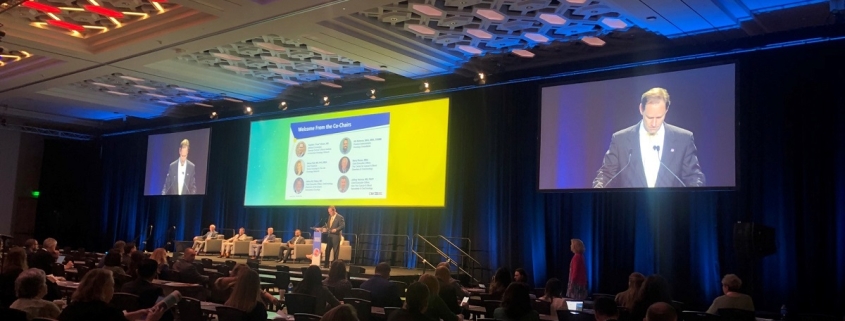Pivoting Toward Oncology’s Future: Perspectives Based on My COA 2022 Experiences
I had the recent honor and privilege to once again co-Chair the Community Oncology Alliance (COA) annual Community Oncology Conference, which featured two days packed with medical updates, legislative updates, best practice patterns, patient advocacy efforts, and networking with colleagues and thought leaders.
As our largest conference to date with over 1,500 attendees, it was a hugely impactful meeting, highlighting and addressing the issues currently facing community oncology practices. This blog shares what I considered to be the main take-aways from the conference, including the challenges and opportunities that lie ahead.
340B
Old story, new verse. We engaged in extensive discussions regarding the ongoing abuses of the 340B Drug Pricing Program.
Although initially developed to improve patient access to care, the 340B program has been hijacked by numerous health systems to fund expansion of hospital-owned physicians and infusion centers. It has, paradoxically, increased patients’ costs due to higher site-of-service fees and subsequent drug price increases issued by Pharma to offset the 340B subsidies to these institutions, thereby actually limiting patient access to care.
Additionally, these 340B-based health systems leverage excess drug margins, pressuring community oncology practices to capitulate and join their fold, again resulting in limited sites of service and higher costs for more patients. This erodes the community oncology platform that repeated studies have shown to be a more efficient and cost-effective means of providing oncology care.
Though Congress has issued some cuts to 340B reimbursement, we as Community Oncology must remain diligent and united in continuing to shed light on program abuses as a major cost-driver in oncology care.
PBMs
The evolution of pharmacy benefit managers’ (PBMs) influence in oncology and specialty care is almost beyond comprehension. They have always been among the most egregious offenders in terms of patient access issues through their use of step-edits, prior authorizations, limited formularies, out-of-network exclusions, and veiled rebate systems which drive price increases.
DIR fees PBMs charge to pharmacies and dispensing practices have increased over 1000% in the past few years with little to no transparency regarding the justification for, or utilization of, these funds.
The vertical integration of PBMs within payers shows how valuable they are as a profit center. The consolidation in this space has left us with only three PBMs managing approximately 80% of prescribed medications in this country – limiting competition, which results in further price increases and even more limited access.
A concerning trend is the exclusion of high-cost drugs from formularies, with PBMs expressly directing the patient and provider to apply for compassionate/free drugs from Pharma. This has become almost epidemic.
Deadly Duo
An unconscionable development is the alliance of PBMs and 340B institutions, which are joining forces to gain access to 340B discount pricing on PBM managed drugs.
Multiple Pharma companies have boycotted this effort, which will undoubtedly drive prices higher. Stay tuned as this will be decided in the courts later this year
OCM and Value-based Models
Another significant issue discussed at COA was the sunsetting of the Centers for Medicare and Medicaid Services’ (CMS) Oncology Care Model (OCM). Though the published data for this model suggested overall minimal financial benefit to CMS, the value to our patients is unquestionable.
Oncology practices throughout the country have dedicated millions of dollars in resources to reposition their practices as value-based sites. Through additional patient support networks and improved 24-7 access to their oncology caregivers, this effort was clearly successful in minimizing high cost, low benefit emergency department visits, hospitalizations, and improving timely access to palliative care services.
The funding for these patient touchpoints is in jeopardy unless a new value-based model is enacted by CMS. Appropriating funding for incentives that improve access to and reduce the cost of care should continue to be a high legislative priority. In the meantime, a pivot to professional case management, transitional care management, and chronic care management programs supported by CMS may offset some of these expenses.
Precision Medicine
No longer a “pie-in-the-sky” quip, precision medicine is rapidly becoming a reality in oncology.
The most cost-effective treatment for our patients will always be the “right” treatment, which is best defined with NGS biomarker panels, whole exome sequencing, RNA/transcriptome sequencing, germline testing, and pharmacogenomics. The complexity involved in the analysis of this tidal wave of data, coupled with the exponential development of targeted agents, creates a challenge for the community oncologist. This data needs to be codified and quantified in a usable format that can be integrated within our EHR’s to power therapeutic decision-making, treatment selection, and monitoring for our individual patients in multiple lines of therapy.
We will likely need to employ the help of artificial intelligence (AI) based solutions to achieve this goal. I strongly believe that Community Oncology will lead the way in this endeavor.
Stay Tuned
The continued growth and success of Community Oncology will be driven by our response to these challenges. How we react to adversity rather than the adversity itself will define our path forward.
Resilience has long been the cornerstone of community oncologists. Fueled by innovation, ingenuity, and a commitment to patient-centered care, we can and will create a brighter tomorrow for our patients and their families.







